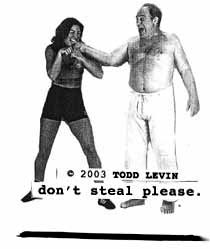


|
|
WE THINK PAUL NEWMAN IS ATTACHED.
Just catching up on last week's New Yorker (i can so read. shut it.) and it was end-to-end good. I subscribe to the magazine because I find, other than the New York Times Magazine, it's the one source that always comes up when people relate interesting stories. It's never, "Did you read that story in this month's Crack'd?..." And it is a good magazine although, on average, I only read about 40% of its contents. Financial Page? Never. Written by Jeffrey Toobin. Almost never. Modern dance legends? Forget it. Even "Shouts and Murmurs," the section I used to most look forward to each week, telegraphs its tired punches so desperately that it usually gets abandoned about three unfunny jokes through. (in that sense, it's not so different from this site.) But last week's issue was a POWERHOUSE - for me, at least. A surprisingly down-to-earth feature on Matthew Barney. A "Talk of the Town" mention (and illustration) of an acquaintance from the NYC comedy scene. (and that only made me a tiny bit jealous and wanting, but not enough to wish ill of demetri, who i still think is talented and very decent at being a human being.) And a nice, long piece of new fiction from George Saunders that gave me the same warm stirrings pre-teen girls get when the new issue of Frilly! magazine boasts a fold-out poster of Justin Timberlake or that guy from Smallville. Suffice it to say, my content ingestion average spiked at about 85%. The best story, however, has been the history of Forrest Tucker, one of America's most notorious bankrobbers and prison escape artists. I haven't finished this piece yet, but it instantly gave me the feeling that some very ambitious and very lazy Hollywood producer just found his next story to option. With a speech like this: "So what do you want to know? I've been in prison all my life, except for the times I've broken out. I was born in 1920, and I was in jail by the time I was fifteen. I'm eighty-one now and I'm still in jail, but I've broken out eighteen times successfully and twelve times unsuccessfully. There were plenty of other times I planned to escape, but there's no point in me telling you about them." you've already got your opening voice-over. The article reads almost exactly like a great, epic film, spanning America's 20th century through fashion, crime, pulp, style, and geography, and seen through the lens of a perfectly smooth, handsome outlaw with a penchant for politeness. My God it's all right there. Then, about 2500 words in, I remembered. The story sounded almost too familiar, and that's because William Goldman had a similar thought. In his book Which Lie Did I Tell? he demonstrates how possible it is to build a story out of something ripped right from the headlines and uses the final (possibly!) arrest of Mr. Tucker as his example. He goes to great trouble to set it up, hypothetically, as an example to aspiring screenwriters. Wild. He provided the premise, but the New Yorker provided the outline. And someone - and we pray it will not be someone like Brian Grazer - will provide the holiday film. The only difference will be that Tucker's age will come down by at least 10 years, and his main accomplice will be a foul-mouthed space alien named Rolo. (after his hearty appetite for "Rolo's" candies.) |


